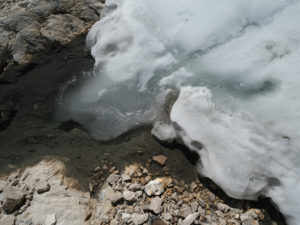The recent flash flood in Uttarakhand was widely called a “glacier burst” although glaciers are not balloons and do not burst. It has spurred renewed warnings that global warming threatens quick melting of the Himalayan glaciers, decimating flows in the Gangetic plain, causing desertification and devastating agriculture. Academics like Brahma Chellaney predict wars from water scarcity.
In 2007 the International Panel on Climate Change incorrectly predicted that all Himalayan glaciers might disappear by 2035, and was obliged to correct itself. Then environment minister Jairam Ramesh commissioned an independent study by glaciologist V K Raina. His report said while glaciers had been melting since the end of the last Ice Age and would continue doing so, melting had not accelerated in recent decades even if temperatures had risen. Raina says glacial melt contributes barely 2% to the flow of the Ganga at Allahabad: rain is the overwhelming source of flow. Corollary: even when all the glaciers melt centuries hence, the river and agriculture will be impacted very modestly.
Even Raina’s 2% estimate may be too high. A 2019 research paper by Richard Armstrong, National Snow and Ice Data Center, USA, with 11 international collaborators is the first study to break down separately the contribution to river flows in Himalayan river basins by (a) snow on land melting; (b) snow on glaciers melting; (c) glacial ice melting; and (d) rainfall.
The study covers only high-altitude areas above 2,000 metres (the altitude of Mussoorie or Darjeeling). This is because river flows in the plains are obviously dominated by rainfall. But even above 2,000 metres, the contribution of exposed glacial melt to river flows in the Ganga basin is less than 1%; of snow on glaciers 4%; of snow on land 43%; and of rainfall 52%. The four contributions in the Indus basin are 2%, 6%,67% and 23%; and in the Brahmaputra basin 1%, 7%, 26% and 66%.
Many readers will be astonished that the contribution of glacial melt can be just under 1% even in the higher Himalayas. The estimates of some other researchers are far higher. The new study suggests the other researchers have failed to distinguish between snowmelt and glacial melt because the technology and data to make the distinction was not easily available earlier, but makes a huge difference.
Raina’s report complained of the woeful lack of Himalayan weather stations to collect data. The Indian Space Research Organisation collects data by satellite, and said in a 2014 report that it had monitored 2,018 Himalayan glaciers between 2001 and 2011. It found that only 248 glaciers were retreating, 1,752 were stable and 18 were advancing. Other studies say most but not all glaciers are retreating. There is net melting but no crisis.
Substantial snow falls in winter. In early summer, snow on land and glaciers starts melting. Snowmelt from high mountains can flow onto the glaciers and be mistaken for glacial melt. After the snow covering glaciers has melted, the exposed glacial ice melts too between June and late September.
This coincides with the monsoon, which then dominates river flows. So, Raina emphasises, it is a myth that glacial melt is critical for river flow in the lean pre-monsoon season. Armstrong shows snowmelt is the key contributor. And snow will continue to fall, melt, and feed the rivers after every glacier disappears centuries hence. This should surprise none: geology shows huge rivers descending from the Himalayas even before the last Ice Age created the glaciers.
All forecasts of the impact of global warming on Himalayan snowfall are highly speculative: we really don’t know. Global warming should increase ocean evaporation and clouds, increasing rain and snow. Its distribution is uncertain.
The area covered by winter snow is many times greater than that covered by glaciers, so it contributes more. Even at the snout of glaciers, where rivers emerge, glacial melt is a minor contributor. Armstrong puts it at just 1-2% at high altitudes. This keeps falling as the river moves downhill and is fed by rain.
In common parlance, glaciers are often but misleadingly called the source of Himalayan rivers. In fact glaciers are merely the highest point of rivers. The actual source of the Ganga is not the Gangotri glacier but every drop of rain that falls on the 860,000sq km of the basin, and then flows downhill to the river. That creates the flow.
The studies of Raina, ISRO and Armstrong will shock those predicting accelerated melting and famine. But distinguishing between snowmelt and glacial melt is good science, and leads to happier conclusions. Let’s rejoice. Glacial retreat will have some adverse side-effects on glacial lakes and flora and fauna. But not even glacial disappearance will mean dry rivers, famine and war.
cold truths: Contrary to what people think, it’s rain and not glaciers that contribute most of the flow to Ganga


